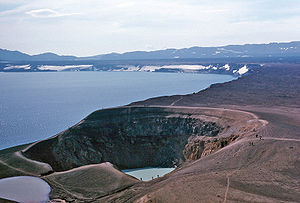Askja
- This article is about the volcano; for the building in Reykjavík, see Askja (building).
| Askja |
|---|
Askja is a stratovolcano situated in a remote part of the central highlands of Iceland (location: 65.03° N, 16.75° W). The name Askja refers to a complex of nested calderas within the surrounding Dyngjufjöll mountains, which rise to 1,510m.
The region is only accessible for a few months of the year. Being situated in the rain-shadow to the NE of the Vatnajökull icecap, the area receives only about 450 mm of rainfall annually. The area was used during training for the Apollo program to prepare astronauts for potential lunar conditions.
Askja was virtually unknown until the tremendous eruption which started on March 29, 1875. Especially in the eastern fjords of Iceland, the ashfall was heavy enough to poison the land and kill livestock. The eruption triggered a substantial wave of emigration from Iceland. The last eruption of the Askja was in 1961.
The outer caldera of Askja, representing a prehistoric eruption, is about 45 km², and there is evidence of other later caldera-forming events within it. The main crater floor lies at about 1,100m.
Öskjuvatn is a large lake that fills much of the smaller caldera resulting from the 1875 eruption. Its surface lies about 50m below the level of the main crater floor and covers about 12km². When the lake originally formed it was warm, but today it is frozen over for most of the year. Öskjuvatn is the deepest lake in Iceland at 220 m deep.
Viti is a smaller explosion crater on the north east shore of Öskjuvatn, approximately 100 metres diameter. It contains a geothermal lake of mineral-rich, sulphurous, opaque blue water, which is maintained at a comfortable temperature for swimming. Víti was formed in the eruption of 1875.
In 1907, the German scientists Walter von Knebel and Max Rudloff visited Askja to study the caldera. While exploring Öskjuvatn in a small boat, they disappeared without a trace. Von Knebel's fiancée Ina von Grumbkow led an expedition to search for them, but no indication of what happened to them was ever found.
In the Dyngjufjöll mountains which surround the Askja caldera can be found the impressive Drekagil, the canyon of dragons. Not far from Askja, there are two other interesting volcanic systems: Herðubreið and Kverkfjöll.
Askja is a popular tourist destination. There are two mountain huts and a campsite at Dreki, by Drekagil, which is located about 100km by unpaved road from the Icelandic ring-road. A dirt road climbs 8km up from Dreki into the Askja caldera. It is a walk of about 2.5km from the car park to Öskjuvatn and Víti. The roads are usually only open for about two or three months in high summer.

See also
- Geography of Iceland
- Glaciers of Iceland
- Iceland plume
- Lakes of Iceland
- List of islands off Iceland
- List of volcanoes in Iceland
- Rivers of Iceland
- Volcanoes of Iceland
- Waterfalls of Iceland
